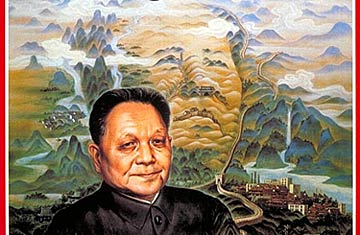
(19 of 20)
The paradoxes can be traced in a single two-day trip down the Yangtze from Chongqing to Wuhan. In Chongqing I visit an electronics plant that makes oscilloscopes and instruments for testing TV equipment. Dust-free and climate-controlled, the plant requires visitors to don clean slippers before entering. Inside are young women of 20 to 25 making circuit panels. They are only three or four years out of the paddy fields, but their product is superior.
Down the Yangtze from Chongqing I see stone hackers carving building blocks out of the riverbed reefs — labor so uselessly expended when concrete is available that it can only be economical if recognized as forced labor. Farther down the river, at Wanxian, a young woman stevedore, of the same age as the oscilloscope workers, bends and stoops; all her muscles quiver as she heaves and finally lifts two huge buckets of pig livers for the third-class passengers. She staggers, makes it, totters up the gangplank. She is followed by other young women, beasts of burden, staggering under the bales, the cartons, the loadings of the vessel. I am pleased to watch them revolt, screaming, shaking fists at the forewoman who commands them. But next morning I am passing through the stark wonder of the gorges themselves and come to Gezhou Ba, the great dam that is the first to harness the Yangtze since nature began melting the snows of the Tibetan highlands to carve a passage to the ocean. All of Gezhou Dam, its machinery, its turbines, locks and spillways, transformers, are of Chinese design and manufacture: advanced technology in any country.
So, all in 48 hours: peasant girls trained to make sophisticated oscilloscopes and circuit boards; forced labor cutting hard rock with mallet and chisel; then young women, treated as beasts; then the pride of Chinese technology.
The journey raises more questions than answers, and the questions plague the Chinese themselves. Why are some young women working in dust-free plants while others slave at muscle work? Who shall be privileged to join at the cutting edge of new enterprise, who left behind? How much relief from suffering can the Zhongyang give its people now, without stealing time and resources from the China of tomorrow?
THE LAST STRUGGLE
When I came to China more than 40 years ago, I came believing it was a land whose pride had been erased. But, watching the Chinese fight Japan, I learned that pride, personal and national, still smoldered. Mao brought it to flame. I watched him change their thinking to that of eternal "strug gle" — better to die than to submit.
The Chinese are still Mao's "struggle" people. They have "struggled" against the Japanese and hate them yet. They have "struggled" against Soviet ideas and repudiated them. They have "struggled" against the barbarities of their own government and leaders, and erased many. Today their struggle is against the realities of their own immense dimensions, the crushing limits of their backwardness. Yet some may find it easier to struggle against an outer enemy to restore national pride. And Americans must recognize that pride as they try to avoid the traps that pride may set. America and China are locked in a narrow, dangerous passage of history. The transition regime in Peking is trying to recapture control of events. But in its own way,
